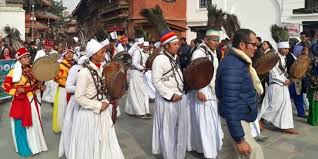Share this Article
In Nepal, food preparation is deeply intertwined with the culture, tradition, and history of the region. Traditional cooking methods, which have been passed down for generations, rely heavily on tools that are as old as the practice of cooking itself. One of the most significant and enduring tools in Nepali kitchens is the stone mill, known locally as the Janto. This humble yet powerful tool has played a central role in food preparation across Nepal, especially in rural areas, where traditional cooking methods are still predominantly used.
The Janto is an essential element in Nepali kitchens, particularly for grinding grains, spices, and herbs into fine powders or pastes. Its use is deeply embedded in the food culture, and it is a testament to the ingenuity and resourcefulness of Nepali households. This article explores the significance, usage, and cultural importance of the Janto in traditional Nepali cooking.
1. What is a Janto?
The Janto (also known as a stone grinder or stone mill) is a traditional grinding tool made from two large, flat, smooth stones. One stone is stationary, while the other is movable. The movable stone is used to grind or crush food items, with the aid of manual labor, often by rotating it using a wooden handle. The two stones are typically made from granite or other hard, durable stones found locally.
The primary function of the Janto is to grind cereals, grains, and spices into powder or paste. Commonly ground items include wheat, rice, maize, lentils, and spices like turmeric, cumin, coriander, and mustard seeds. In some rural communities, the Janto is also used to prepare herbal remedies, pastes for rituals, and pickles (achar).
2. The Role of the Janto in Traditional Nepali Cooking
In traditional Nepali kitchens, the Janto plays an indispensable role in food preparation, especially when making staple dishes such as dal (lentil soup), roti (flatbread), and bhat (rice). Some of the most common uses of the Janto include:
2.1 Grinding Grains
The Janto has long been used for grinding grains such as wheat and rice to make flour for various dishes. In rural areas, the Janto is still used to prepare fresh whole wheat flour for roti and puris (deep-fried flatbreads), which are staple foods in many Nepali households. The act of grinding wheat or rice manually using the Janto is seen as a slow, meditative process that connects the cook to the food, reinforcing the idea of care and intention in cooking.
2.2 Making Spice Pastes and Masalas
The Janto is widely used to grind spices into fresh pastes or masalas, which are essential for Nepali cooking. The stones' rough surfaces ensure that the spices are ground to the perfect consistency, releasing their essential oils and flavors. Freshly ground spice mixes, such as garam masala or turmeric paste, are key to Nepali curries, dal, and other dishes.
This process is important because it ensures that the spices maintain their natural flavors and fragrances, unlike pre-ground spices which tend to lose potency over time. For instance, mustard seeds, cumin, and fenugreek are commonly ground in the Janto to create aromatic spice blends that are the foundation of Nepali cooking.
2.3 Making Pastes for Pickles (Achar)
In Nepali cuisine, achar (pickles) are an essential side dish that accompanies almost every meal. These spicy, tangy, and sometimes sweet condiments are made from a variety of vegetables, fruits, or even meats, and often require the grinding of ingredients to make a paste. The Janto is used to grind ingredients like ginger, garlic, green chilies, and mustard seeds, which are then mixed with oil and other spices to make traditional Nepali pickles.
The grinding process ensures that the ingredients are finely processed, allowing them to blend together seamlessly and release their full flavors. Some households also use the Janto to grind fresh herbs for making chutneys, another integral part of Nepali meals.
2.4 Preparing Flour for Traditional Flatbreads (Roti and Aloo Paratha)
In Nepali cuisine, flatbreads are a staple, and the Janto has traditionally been used to grind flour from wheat or rice to make dough for roti, paratha, and puris. The process of grinding flour on the Janto is an essential step that enhances the texture of the bread, giving it a finer and softer consistency compared to mechanically milled flour. The freshly ground flour from the Janto gives an extra level of authenticity and freshness to these traditional bread preparations.
2.5 Making Herbal and Medicinal Pastes
Beyond culinary purposes, the Janto is also used for preparing herbal and medicinal pastes. In traditional Nepali medicine, many herbal remedies are made from plants that are ground into pastes to treat various ailments. The Janto’s rough surface is ideal for grinding leaves, roots, and bark into fine powders or pastes, which are then used for their healing properties. For instance, turmeric, neem leaves, and tulsi (holy basil) are often ground on the Janto for medicinal purposes.
3. Cultural Significance of the Janto
The Janto is much more than a functional tool in Nepali cooking; it is an integral part of the cultural and social life of Nepalese people. In rural communities, the Janto is often used as a communal tool. Neighbors, friends, and family members may gather at one home to grind grains or spices together, creating an opportunity for socializing and bonding. The grinding of food using the Janto is a ritualistic act that connects people to their food, to the land, and to the community.
In some regions, grinding grain and spices on the Janto is accompanied by chants or songs that are passed down through generations. The rhythmic sound of grinding on the Janto often serves as a background to daily life, adding to the atmosphere of traditional Nepali households.
The Janto also symbolizes sustainability and self-reliance. In rural areas where electricity may not be readily available, the manual operation of the Janto ensures that food preparation remains independent of modern technology. This makes the Janto a symbol of resilience and adaptability, deeply tied to the agricultural and rural economy of Nepal.
4. Modern-Day Relevance of the Janto
Although modern kitchen appliances such as blenders, mixers, and grinders are increasingly popular, the Janto continues to be used in many rural households. Its durability, simplicity, and the quality of the end product make it indispensable for many Nepali families who prefer traditional methods of cooking.
In urban areas, the use of the Janto is somewhat declining, but it is still maintained as a part of the cultural heritage. Many people in cities keep a Janto at home as a symbol of their heritage, using it for special occasions or rituals. Additionally, with the growing interest in slow food, organic cooking, and sustainable practices, there is a renewed appreciation for the use of the Janto in both cooking and food preparation.
5. Conclusion
The Janto remains an enduring symbol of Nepali tradition, culture, and craftsmanship. It embodies the deep connection between Nepali people and their food, as well as the longstanding importance of manual labor and communal engagement in daily life. As Nepali cuisine continues to be appreciated globally for its flavors, spices, and authenticity, the Janto serves as a reminder of the roots of Nepali cooking, rooted in the land, the community, and the enduring tradition of hand craftsmanship. Its continued use in kitchens across Nepal highlights the importance of preserving these traditional practices for future generations.
Categories:
History & Heritage
,
Lifestyle & Local Life
Tags:
Heritage







